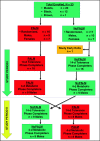Calcium and fat metabolic balance, and gastrointestinal tolerance in term infants fed milk-based formulas with and without palm olein and palm kernel oils: a randomized blinded crossover study
- PMID: 24367946
- PMCID: PMC3877982
- DOI: 10.1186/1471-2431-13-215
Calcium and fat metabolic balance, and gastrointestinal tolerance in term infants fed milk-based formulas with and without palm olein and palm kernel oils: a randomized blinded crossover study
Abstract
Background: Effects of palm olein (POL) on calcium and fat metabolic balance and gastrointestinal (GI) tolerance have been clinically evaluated but its use in combination with palm kernel oil (PKO), and canola oil has not been similarly assessed in infants.
Methods: Calcium and fat balance and GI tolerance were evaluated in 33 healthy term infants (age = 68-159 d) in a randomized, double-blinded, 14 d crossover trial at a day care center in Salvador, Brazil; followed by a 4d hospital ward metabolic balance study in 17 of the male subjects. The study compared two commercially available milk-based powdered formulas in Brazil; one containing POL (44% of total fat), PKO (21.7%) and canola oil (18.5%) as predominant fats (PALM), and the other containing none (NoPALM). Occasional human milk (HM) supplementation was allowed at home.
Results: Formula and HM intakes, and growth were not different (p > 0.05). Calcium absorption (%) for infants fed NoPALM (58.8 ± 16.7%; means ± SD) was higher (p = 0.023) than those fed PALM (42.1 ± 19.2%), but was not significant (p = 0.104) when calcium intake was used as a covariate. Calcium intake was higher (p < 0.001) in NoPALM versus PALM fed infants. However, calcium retention (%) was higher in infants fed NoPALM compared to PALM with (p = 0.024) or without (p = 0.015) calcium intake as a covariate. Fat absorption (%) for NoPALM was greater than PALM fed infants (NoPALM = 96.9 ± 1.2 > PALM = 95.1 ± 1.5; p = 0.020 in Study Period I). Mean rank stool consistency was softer in infants fed NoPALM versus PALM (p < 0.001; metabolic period). Adverse events, spit-up/vomit, fussiness and gassiness were not different (p > 0.05). Formula acceptability was high and comparable for both formula feedings, regardless of HM supplementation.
Conclusions: Term infants fed PALM based formula (containing palm olein, palm kernel and canola oils) demonstrated lower calcium retention and fat absorption, and less softer stool consistency versus infants fed NoPALM based formula. Study suggested formula fat differences may affect GI function in infants.
Trial registration: ClinicalTrials.gov NCT00941564.
Figures
Similar articles
-
Milk protein-based formulas containing different oils affect fatty acids balance in term infants: A randomized blinded crossover clinical trial.Lipids Health Dis. 2017 Apr 14;16(1):78. doi: 10.1186/s12944-017-0457-y. Lipids Health Dis. 2017. PMID: 28410612 Free PMC article. Clinical Trial.
-
Lower calcium absorption in infants fed casein hydrolysate- and soy protein-based infant formulas containing palm olein versus formulas without palm olein.J Am Coll Nutr. 2002 Dec;21(6):564-9. doi: 10.1080/07315724.2002.10719256. J Am Coll Nutr. 2002. PMID: 12480803 Clinical Trial.
-
Palm olein in infant formula: absorption of fat and minerals by normal infants.Am J Clin Nutr. 1996 Sep;64(3):291-6. doi: 10.1093/ajcn/64.3.291. Am J Clin Nutr. 1996. PMID: 8780336 Clinical Trial.
-
A Scoping Review of Clinical Studies in Infants Fed Formulas Containing Palm Oil or Palm Olein and Sn-2 Palmitate.J Nutr. 2021 Oct 1;151(10):2997-3035. doi: 10.1093/jn/nxab246. J Nutr. 2021. PMID: 34510181 Free PMC article.
-
Intake of Palm Olein and Lipid Status in Healthy Adults: A Meta-Analysis.Adv Nutr. 2019 Jul 1;10(4):647-659. doi: 10.1093/advances/nmy122. Adv Nutr. 2019. PMID: 31095284 Free PMC article.
Cited by
-
Lipid Quality in Infant Nutrition: Current Knowledge and Future Opportunities.J Pediatr Gastroenterol Nutr. 2015 Jul;61(1):8-17. doi: 10.1097/MPG.0000000000000818. J Pediatr Gastroenterol Nutr. 2015. PMID: 25883056 Free PMC article. Review.
-
Role of lipidomics in assessing the functional lipid composition in breast milk.Front Nutr. 2022 Sep 2;9:899401. doi: 10.3389/fnut.2022.899401. eCollection 2022. Front Nutr. 2022. PMID: 36118752 Free PMC article. Review.
-
Variation in Infant Formula Macronutrient Ingredients Is Associated with Infant Anthropometrics.Nutrients. 2020 Nov 12;12(11):3465. doi: 10.3390/nu12113465. Nutrients. 2020. PMID: 33198077 Free PMC article.
-
Comparison Among Commonly Available Infant Formula Milks in the Iraqi Market.Glob Pediatr Health. 2015 Oct 6;2:2333794X15608716. doi: 10.1177/2333794X15608716. eCollection 2015. Glob Pediatr Health. 2015. PMID: 27335982 Free PMC article.
-
Polyunsaturated fatty acid supplementation in infancy for the prevention of allergy.Cochrane Database Syst Rev. 2016 Oct 28;10(10):CD010112. doi: 10.1002/14651858.CD010112.pub2. Cochrane Database Syst Rev. 2016. PMID: 27788565 Free PMC article.
References
-
- Tomarelli RM, Meyer BJ, Weaber JR, Bernhart FW. Effect of positional distribution on the absorption of the fatty acids of human milk and infant formulas. J Nutr. 1968;13:583–59. - PubMed
-
- Jensen C, Buist NRM, Wilson T. Absorption of individual fatty acids from long chain or medium chain triglycerides in very small infants. Am J Clin Nutr. 1986;13:745–751. - PubMed
-
- Christie WW, Nikolova-Damyanove, Laakso P, Herslof B. Stereospecific analysis of triacyl-sn-glycerols via resolution of diasteromeric diacylglycerol derivatives by high-performance liquid chromatography on silica. J Am Chem Soc. 1991;13:695–701.
Publication types
MeSH terms
Substances
Associated data
LinkOut - more resources
Full Text Sources
Other Literature Sources
Medical



